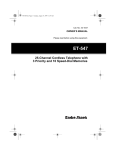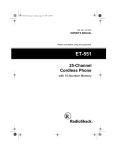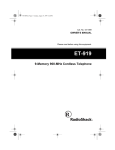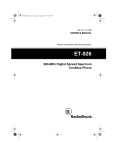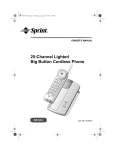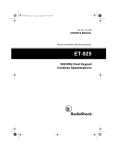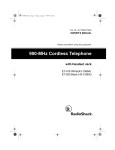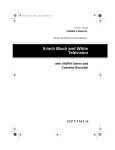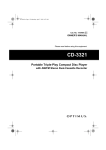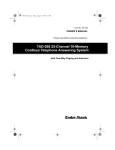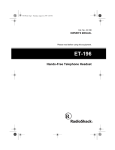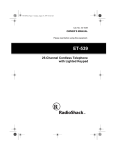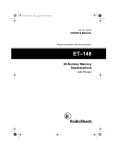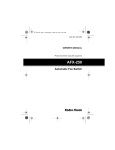Download Radio Shack ET-542 Owner`s manual
Transcript
43-1052.fm Page 1 Tuesday, August 17, 1999 1:19 PM Cat. No. 43-1052 OWNER’S MANUAL Please read before using this equipment. ET-542 All-Weather 25-Channel Cordless Telephone 43-1052.fm Page 2 Tuesday, August 17, 1999 1:19 PM FEATURES Your RadioShack ET-542 All-Weather 25-Channel Cordless Telephone includes the latest advances in cordless phone technology. COM-LOK‚ — ensures that other cordless phone users cannot use your phone line while the handset is on the base. One of the phone’s most valuable features is that the handset is water resistant, which makes it perfect for outdoor use, especially around the pool. Automatic Security Access Protection Code — changes each time you disconnect and restore power to the base to help prevent other cordless phone users from using your phone line while the handset is off the base. Caution: The phone’s handset is not waterproof. Do not submerge it in water. The ET-542 also includes these features: Auto-Scan — automatically selects a clear channel when you pick up the phone. Flash — sends an electronic switchhook signal for use with special phone services such as call waiting. Redial — with the touch of a button, quickly redials the last number dialed. Touch Tone or Pulse (Rotary) Dialing — lets you connect your phone to either type of service. 25-Channel Selector — lets you manually change channels during a call to find the one with the least interference. Hearing-Aid Compatibility — lets you use your phone with hearing aids that have a T (telephone) switch. 10-Number Memory — lets you store 10 phone numbers in memory for easy dialing. Please read this Owner’s Manual carefully so you can enjoy all of your telephone’s features. Advanced Super CCT Circuitry — provides clarity comparable to a corded phone, reduces background noise, and increases the effective operating distance. © 1998 Tandy Corporation. All Rights Reserved. COM-LOK and RadioShack are registered trademarks used by Tandy Corporation. 2 43-1052.fm Page 3 Tuesday, August 17, 1999 1:19 PM Important: Cordless phones such as this one require AC power to operate. When the AC power is off, you cannot dial out or receive incoming calls using your ET-542. For this reason, the ET-542 cordless phone should not be your only telephone. To be safe, you should also have a phone that does not need AC power to operate (not a cordless phone) so you can still make and receive calls if there is an AC power failure. Warning: To prevent fire or shock hazard, do not expose this product to rain or moisture. CAUTION RISK OF ELECTRIC SHOCK. DO NOT OPEN. CAUTION: TO REDUCE THE RISK OF ELECTRIC SHOCK, DO NOT REMOVE COVER OR BACK. NO USER-SERVICEABLE PARTS INSIDE. REFER SERVICING TO QUALIFIED PERSONNEL. This telephone has been tested and found to comply with all applicable UL and FCC standards. Your ET-542 operates on standard radio frequencies, as allocated by the FCC. Therefore, it is possible for other radio units operating on similar frequencies, within a certain area, to inadvertently intercept your conversations and/or cause interference on your cordless telephone. This lack of privacy can occur with any cordless telephone. ! This symbol is intended to alert you to the presence of uninsulated dangerous voltage within the product’s enclosure that might be of sufficient magnitude to constitute a risk of electric shock. Do not open the product’s case. ! This symbol is intended to inform you that important operating and maintenance instructions are included in the literature accompanying this product. For your records, we urge you to record the serial number of your phone in the space below. The serial number is on the bottom panel of the base. Serial Number ______________ 3 43-1052.fm Page 4 Tuesday, August 17, 1999 1:19 PM READ THIS BEFORE INSTALLATION We have designed your telephone to conform to federal regulations, and you can connect it to most telephone lines. However, each device that you connect to the phone line draws power from the phone line. We refer to this power draw as the device’s ringer equivalence number, or REN. The REN is shown on the bottom of your phone’s base. If you are using more than one phone or other device on the line, add up all the RENs. If the total is more than five, your phone might not ring. In rural areas, a total REN of three might impair ringer operation. If ringer operation is impaired, remove a device from the line. 4 FCC STATEMENT This telephone complies with Part 68 of FCC Rules. You must, upon request, provide the FCC registration number and the REN to your phone company. These numbers are located on the bottom of your phone’s base. Note: You must not connect your phone to any of the following: • Coin-operated systems • Party-line systems • Most electronic key phone systems 43-1052.fm Page 5 Tuesday, August 17, 1999 1:19 PM CONTENTS Installation ............................................................................................................ 6 Selecting a Location ........................................................................................ 6 Installing the Base ........................................................................................... 6 Preparation ........................................................................................................... Connecting the Battery ................................................................................... Charging the Battery ....................................................................................... Setting the Dialing Mode ................................................................................. Turning On/Off the Ringer ............................................................................... Operation ............................................................................................................ Making/Answering a Call .............................................................................. Using the Handset at the Base ............................................................... Using the Handset away from the Base ................................................. Changing Channels ...................................................................................... Using Redial .................................................................................................. Using Flash ................................................................................................... Using Tone Services on a Pulse Line ........................................................... Using Page ................................................................................................... Memory Dialing ............................................................................................. Storing a Number in Memory .................................................................. Entering a Pause in a Memory Number ................................................. Dialing a Stored Number ........................................................................ Storing/Chain Dialing Service Numbers ................................................. Testing Stored Emergency Numbers ...................................................... 7 7 8 9 9 10 10 10 10 11 11 11 12 12 12 13 14 14 14 14 Troubleshooting ................................................................................................ 15 Care and Maintenance ...................................................................................... Replacing the Battery .................................................................................... The FCC Wants You to Know ....................................................................... Lightning ....................................................................................................... 17 18 19 19 5 43-1052.fm Page 6 Tuesday, August 17, 1999 1:19 PM INSTALLATION SELECTING A LOCATION Select a dry location for the telephone’s base that is: correctly fit the phone’s 12V DC jack. The supplied adapter meets these requirements. Using an adapter that does not meet these requirements could damage the phone or the adapter. • Near an AC outlet • Near a telephone line jack • Out of the way of normal activities • Away from electrical machinery, electrical appliances, and metal walls or filing cabinets INSTALLING THE BASE illustration • Away from wireless intercoms, alarms, and room monitors The base’s location affects the phone’s range. If you have a choice of several locations, try each to see which provides the best performance. Note: If the phone line jack is not a modular jack, you must update the wiring yourself, using jacks and adapters available at your local RadioShack store. Or, you can let the phone company update the wiring for you. • The phone company will charge you for the installation of the necessary jacks. • The USOC number of the jack to be installed is RJ11C for a baseboard jack or RJ11W for a wall jack. Caution: You must use a Class 2 120V AC/12V DC adapter that delivers at least 200 milliamps with its center tip set to positive. Its plug must 6 1. Plug one end of the supplied modular cord into the TEL.LINE jack on the back of the base. 2. Plug the modular cord’s other end into a modular phone line jack. 3. Insert the supplied AC adapter’s barrel plug into the 12V DC jack on the back of the base. 4. Plug the adapter into a standard AC outlet. 5. Place the base’s antenna in a vertical position. 43-1052.fm Page 7 Tuesday, August 17, 1999 1:19 PM PREPARATION CONNECTING THE BATTERY Important: You must connect the battery inside the handset before charging the phone and using it. Follow these steps to connect the battery. 1. Use a screwdriver to remove the screw on the battery compartment cover on the back of the handset, then press down on the cover and slide it off. 2. Plug the battery wire connector into the socket inside the compartment. 3. Align the screw hole on the battery compartment cover with the screw hole inside the battery compartment. 4. Tighten the screw about halfway. Then press down and slide the cover up to lock it in place. 5. Fully tighten the screw to ensure the best water seal. Before you use your phone for the first time, charge it for 15 hours. Note: The connector fits only one way. Do not force it. 7 43-1052.fm Page 8 Tuesday, August 17, 1999 1:19 PM CHARGING THE BATTERY After you install a new battery, place the handset on the base and let the battery charge for about 15 hours before you use it the first time. The IN USE/CHARGE indicator lights. resets the security access protection code. • If the IN USE/CHARGE indicator does not light when you place the handset on the base, be sure the battery is connected to the socket inside the battery compartment and the AC adapter is securely connected to the base. Also, be sure the handset is placed properly on the base, so the charging contacts on the handset and base meet. The phone recharges whenever the handset is on the base. You can recharge the battery at any time, but you must be sure to recharge the battery when the BATT LOW indicator flashes on the handset. illustration Notes: • The first time you use your phone after installing a new battery, the handset might not work or might sound an error tone when you press TALK. This might also occur when you recharge a battery that has been completely discharged. If this happens, return the handset to the base for 5 seconds. This 8 If the contacts are dirty or tarnished, gently clean them with a pencil eraser. (illus with callout: Charging Contacts) • About once a month, fully discharge the battery by keeping the handset off the base until the BATT LOW indicator flashes. Then return the handset to the base and recharge the battery for 15 hours. 43-1052.fm Page 9 Tuesday, August 17, 1999 1:19 PM SETTING THE DIALING MODE TURNING ON/OFF THE RINGER Set TONE/PULSE on the back of the base for the type of service you have. If you are not sure which type you have, do this test. To turn off the ringer, press and hold RINGER ON/OFF for about 2 seconds (until a long beep sounds). When the ringer is off, the RINGER ON/OFF button flashes red. 1. Set TONE/PULSE to TONE. To turn on the ringer, press and hold RINGER ON/OFF for about 2 seconds (until a short beep sounds). illustration 2. Lift the handset, press TALK, and listen for a dial tone. 3. Press any number other than 0. If the dial tone stops, you have touch-tone service. Leave TONE/ PULSE set to TONE . Note: With the handset’s ringer off, you can still make or receive calls using the cordless phone. Telephones on the same line still ring when there is an incoming call, and the TALK light on the handset and the IN USE/ CHARGE indicator on the base flash until you answer the call. If the dial tone continues, you have pulse service. Set TONE/ PULSE to PULSE . 9 43-1052.fm Page 10 Tuesday, August 17, 1999 1:19 PM OPERATION MAKING/ANSWERING A CALL To disconnect a call, replace the handset on the base. You can use your cordless telephone at the base or away from the base. Using the Handset away from the Base Using the Handset at the Base To make or answer a call, press TALK so the TALK light on the handset turns on. You can use the handset at the base like a regular corded telephone. Just place the handset on the base. To disconnect a call, press TALK so the TALK light turns off. illustration To answer a call, lift the handset from the base. To make a call, lift the handset from the base and press TALK . The TALK light on the handset turns on and the IN USE/CHARGE indicator on the base lights. illustration 10 Note: You can make or answer a call on another phone on the same line as the cordless phone, even if the handset is away from the base. 43-1052.fm Page 11 Tuesday, August 17, 1999 1:19 PM CHANGING CHANNELS Your ET-542’s auto-scan feature automatically selects a clear channel when you pick up the phone. If you experience interference during a call, press CH to switch to another channel (25 in all) until you receive better reception. Note: We recommend you not use REDIAL/PAUSE to dial numbers that include a tone entry (TONE/ ) (see “Us- ing Tone Services on a Pulse Line”). USING FLASH Use FLASH on the handset to perform the switchhook operation for special services, such as call waiting. illustration illustration USING REDIAL To quickly redial the last number dialed, simply lift the handset and press TALK , then press REDIAL/PAUSE. For example, if you have call waiting, press FLASH to take an incoming call without disconnecting the current call. Press FLASH again to return to the first call. Notes: illustration • If you do not have call waiting, pressing FLASH might disconnect the current call. • The redial memory does not store a FLASH entry or any digits entered after you press FLASH. The redial memory holds up to 80 digits in the tone mode or 79 digits in the pulse mode. The redial memory also holds pause entries (see “Entering a Pause” under “Memory Dialing”). 11 43-1052.fm Page 12 Tuesday, August 17, 1999 1:19 PM USING TONE SERVICES ON A PULSE LINE Some special services, such as bank by phone, require tone signals. If you have pulse service, you can still use these special tone services by following these steps. illustration 1. Set TONE/PULSE on the base to PULSE. 2. Dial the service’s main number. 3. When the service answers, press TONE/ on the keypad. Then dial the additional numbers. The phone sends these numbers as tone signals. 4. When you complete the call, place the handset on the base or press TALK to disconnect the call. The phone automatically resets to the pulse mode. USING PAGE The PAGE feature lets you send a page from the base to the handset, so you can page someone at the handset or locate it if you misplaced it. When the handset is not in use and someone presses PAGE on the base, the handset beeps three sets of two beeps. The TALK light on the handset and the IN USE/CHARGE indicator on the base flash. 12 Note: The handset will not beep during a call. MEMORY DIALING You can store up to 10 numbers for two-button dialing. Each stored number can be up to 16 digits long. Notes: • Do not store a number with both pulse and tone entries in the same memory location. This could result in a wrong number being dialed. • If TONE/PULSE is set to PULSE and you want to use tone dialing for a memory number, store the tone entry (TONE/ ) in the next memory location. • To keep your accounts secure, we recommend you do NOT store your personal access code for services such as bank-by-phone in a memory location. 43-1052.fm Page 13 Tuesday, August 17, 1999 1:19 PM Storing a Number in Memory 1. Press MEMORY. illustration Note: While you are storing a number in memory, if you do not press any button on the keypad within about 10 seconds, a buzz sounds. You must start the process over from the beginning. 2. Dial the phone number you want to store. 3. Press MEMORY again. 4. Press the memory location number ( 0-9) where you want to store the number. A long beep sounds. The phone number is now stored in memory. 6. Repeat Steps 1-5 to store other telephone numbers. Notes: • If you receive a call while you are storing a number in memory, press TALK to answer the call. After the call, begin again at Step 1 to store the number. • To change a number stored in memory, simply store a new number in that memory location. • To clear a memory location so no number is stored there, press MEMORY twice, then press the memory location number. A long beep sounds. The number is now cleared from memory. If a buzz sounds, you did not successfully clear the memory location. Try the process again. 5. Pull out the memory index card from the right side of the base. Write the person’s or company’s name and memory location number on the card in pencil (in case you want to store a different number later). illustration 13 43-1052.fm Page 14 Tuesday, August 17, 1999 1:19 PM Entering a Pause in a Memory Number In some telephone systems, you must dial an access code (9, for example) and wait for a second dial tone before you can dial an outside number. If your phone is connected to one of these systems, you might want to enter a pause after the access code when you store a phone number in memory. At the appropriate place in the number, press REDIAL/PAUSE to enter a 2second pause. For a longer pause, press REDIAL/PAUSE again. Dialing a Stored Number Follow these steps to dial a number stored in memory. 1. Lift the handset and press TALK so the TALK light turns on. 2. When you hear a dial tone, press MEMORY and then press the correct memory location number. The phone dials the stored number. Storing/Chain Dialing Service Numbers When storing numbers for special services (such as alternate long distance or bank-by-phone), store the service’s main phone number in one memory location and numbers for additional information in others. 14 To chain dial memory numbers, follow these steps. 1. With the TALK light on, press MEMORY and the memory location number for the service’s main number. 2. Wait for the service to answer. Note: If you use pulse dialing to dial the service, be sure you have stored a tone entry (TONE/ ) in the next memory location before the numbers for the additional information. 3. Press MEMORY and the memory location numbers for the additional information. 4. To disconnect the call, press TALK so the TALK light turns off, or simply replace the handset on the base. Testing Stored Emergency Numbers If you store an emergency service’s number (police department, fire department, ambulance) and you want to test the stored number, make the test call during the late evening or early morning hours to avoid peak demand periods. Remain on the line to explain the reason for your call. 43-1052.fm Page 15 Tuesday, August 17, 1999 1:19 PM TROUBLESHOOTING We do not expect you to have any problems with your telephone, but if you do, the following suggestions might help. If you still have problems, check other phones on the same line to see if they work properly. If they do and the problem does not seem to be with your phone service, take your phone to your local RadioShack store for assistance. Problem: The handset does not work. Solutions: • Move the handset closer to the base. • Place the base’s antenna in a vertical position. • Be sure the phone line cord and AC adapter are correctly and securely connected. • Be sure the battery is properly installed and securely connected. • Be sure the battery is charged. • Return the handset to the base for 5 seconds, then try again. Problem: Call is noisy. Solutions: • Press CH to switch to another channel. • Do not install the base near appliances or large metal objects. • Hang up and redial the number. • Keep the handset away from interference sources such as computers, remote control toys, wireless microphones, wireless alarm systems, wireless intercoms and room monitors, fluorescent lights, and electrical appliances. If the interference is severe, turn off the interfering device. Problem: The handset’s range decreases. Solutions: • Place the base’s antenna in a vertical position. • Return the handset to the base and recharge the battery. Problem: Volume drops or you hear unusual sounds. Solution: Someone has picked up another phone on the same line. Hang up the other phone. 15 43-1052.fm Page 16 Tuesday, August 17, 1999 1:19 PM Problem: Receiver sound flutters or fades. Problem: Can receive calls, but cannot make calls. Solutions: Solution: Set TONE/PULSE for the type of service you have. • Move the handset closer to the base. • Place the base’s antenna in a vertical position. • Be sure the battery is charged. Problem: Can make calls, but telephone does not ring. Solutions: • The handset's ringer might be off. Press and hold RINGER ON/OFF for about 2 seconds until a short beep sounds. (See “Turning On/ Off the Ringer.”) • The telephone company might be using unusual ringing methods. Your telephone is designed for standard straight line bridged ringing. 16 Problem: You cannot answer/make a call and the handset sounds an error tone when you lift it from the base or press TALK. Solution: The phone might be receiving interference from another RF signal; or, if the handset is away from the base during a long period of AC power failure, the phone might lose its security access protection code. Return the handset to the base for 5 seconds, then try again. 43-1052.fm Page 17 Tuesday, August 17, 1999 1:19 PM CARE AND MAINTENANCE Your ET-542 All-Weather 25-Channel Cordless Telephone is an example of superior design and craftsmanship. The following suggestions will help you care for your phone so you can enjoy it for years. Keep the base dry. If the handset gets wet, wipe it dry as soon as you can. Liquids can contain minerals that corrode the electronic circuits. Handle the phone gently and carefully. Dropping it can damage circuit boards and cases and cause the phone to work improperly. Use and store the phone only in normal temperature environments. Temperature extremes can shorten the life of electronic devices and distort or melt plastic parts. Keep the phone away from dust and dirt which can cause premature wear of parts. Wipe the phone with a damp cloth occasionally to keep it looking new. Do not use harsh chemicals, cleaning solvents, or strong detergents to clean your phone. Modifying or tampering with the phone’s internal components can cause a malfunction and might invalidate its warranty and void your FCC authorization to operate it. If your phone is not performing as it should, take it to your local RadioShack store for assistance. If the trouble is affecting the phone lines, the phone company might ask you to disconnect your phone until you have resolved the problem. 17 43-1052.fm Page 18 Tuesday, August 17, 1999 1:19 PM REPLACING THE BATTERY If you follow the instructions in “Charging the Battery,” the supplied battery should last about a year. When the battery loses its ability to fully charge, order a 3.6-volt, 300-mAH battery with a connector that fits the socket in the battery compartment. You can order a replacement battery through your local RadioShack store. Install the new battery as described below, then charge the battery (see “Charging the Battery”). Note: The connector fits only one way. Do not force it. 4. Align the screw hole on the battery compartment cover with the screw hole inside the battery compartment. 1. Use a screwdriver to remove the screw on the battery compartment cover on the back of the handset, then press down on the cover and slide it off. 5. Tighten the screw about halfway. Then press down and slide the cover up to lock it in place. 2. Gently pull on the battery connector to disconnect it, then remove the battery. 3. Plug the battery wire connector into the socket inside the compartment, and place the battery inside the compartment. 18 6. Fully tighten the screw to ensure the best water seal. 43-1052.fm Page 19 Tuesday, August 17, 1999 1:19 PM Important: Your telephone contains a rechargeable nickel cadmium battery. At the end of the battery’s useful life, it must be recycled or disposed of properly. Contact your local, county, or state hazardous waste management authorities for information on recycling or disposal programs in your area. Some options that might be available are: municipal curb-side collection, drop off boxes at retailers, recycling collection centers, and mail back programs. THE FCC WANTS YOU TO KNOW In the unlikely event that your phone causes problems on the phone line, the phone company can temporarily discontinue your service. If this happens, the phone company attempts to notify you in advance. If advance notice is not practical, the phone company notifies you as soon as possible and advises you of your right to file a complaint with the FCC. Also, the phone company can make changes to its lines, equipment, operations, or procedures that could affect the operation of the phone. The phone company notifies you of these changes in advance, so you can take the necessary steps to prevent interruption of your phone service. properly. To determine whether your phone is causing the interference, turn off your phone. If the interference goes away, your phone is causing the interference. Try to eliminate the interference by: • Moving your phone away from the receiver • Connecting your phone to an AC outlet that is on a different electrical circuit from the receiver • Contacting a radio/TV technician or your local RadioShack store for help If you cannot eliminate the interference, the FCC requires that you stop using your phone. LIGHTNING Your phone has built-in protection circuits to reduce the risk of damage from surges in phone line current. These protection circuits meet or exceed FCC requirements. However, lightning striking the phone lines can damage your phone. Lighting damage is not common. Nevertheless, if you live an area that has severe electrical storms, we suggest that you unplug your phone during storms to reduce the possibility of damage. Your phone might cause TV or radio interference even when it is operating 19 43-1052.fm Page 20 Tuesday, August 17, 1999 1:19 PM Limited Ninety-Day Warranty This product is warranted by RadioShack against manufacturing defects in material and workmanship under normal use for ninety (90) days from the date of purchase from RadioShack companyowned stores and authorized RadioShack franchisees and dealers. EXCEPT AS PROVIDED HEREIN, RadioShack MAKES NO EXPRESS WARRANTIES AND ANY IMPLIED WARRANTIES, INCLUDING THOSE OF MERCHANTABILITY AND FITNESS FOR A PARTICULAR PURPOSE, ARE LIMITED IN DURATION TO THE DURATION OF THE WRITTEN LIMITED WARRANTIES CONTAINED HEREIN. EXCEPT AS PROVIDED HEREIN, RadioShack SHALL HAVE NO LIABILITY OR RESPONSIBILITY TO CUSTOMER OR ANY OTHER PERSON OR ENTITY WITH RESPECT TO ANY LIABILITY, LOSS OR DAMAGE CAUSED DIRECTLY OR INDIRECTLY BY USE OR PERFORMANCE OF THE PRODUCT OR ARISING OUT OF ANY BREACH OF THIS WARRANTY, INCLUDING, BUT NOT LIMITED TO, ANY DAMAGES RESULTING FROM INCONVENIENCE, LOSS OF TIME, DATA, PROPERTY, REVENUE, OR PROFIT OR ANY INDIRECT, SPECIAL, INCIDENTAL, OR CONSEQUENTIAL DAMAGES, EVEN IF RadioShack HAS BEEN ADVISED OF THE POSSIBILITY OF SUCH DAMAGES. Some states do not allow the limitations on how long an implied warranty lasts or the exclusion of incidental or consequential damages, so the above limitations or exclusions may not apply to you. In the event of a product defect during the warranty period, take the product and the RadioShack sales receipt as proof of purchase date to any RadioShack store. RadioShack will, at its option, unless otherwise provided by law: (a) correct the defect by product repair without charge for parts and labor; (b) replace the product with one of the same or similar design; or (c) refund the purchase price. All replaced parts and products, and products on which a refund is made, become the property of RadioShack. New or reconditioned parts and products may be used in the performance of warranty service. Repaired or replaced parts and products are warranted for the remainder of the original warranty period. You will be charged for repair or replacement of the product made after the expiration of the warranty period. This warranty does not cover: (a) damage or failure caused by or attributable to acts of God, abuse, accident, misuse, improper or abnormal usage, failure to follow instructions, improper installation or maintenance, alteration, lightning or other incidence of excess voltage or current; (b) any repairs other than those provided by a RadioShack Authorized Service Facility; (c) consumables such as fuses or batteries; (d) cosmetic damage; (e) transportation, shipping or insurance costs; or (f) costs of product removal, installation, set-up service adjustment or reinstallation. This warranty gives you specific legal rights, and you may also have other rights which vary from state to state. RadioShack Customer Relations, Dept. W, 100 Throckmorton St., Suite 600, Fort Worth, TX 76102 We Service What We Sell 3/97 RadioShack A Division of Tandy Corporation Fort Worth, Texas 76102 1A8 Printed in Hong Kong




















